Press Releases

05/22/2016
Gov. Malloy: Graduation Rates Reach Record High
Highest Need Districts Continue to Make Significant Improvements
(HARTFORD, CT) - Governor Dannel P. Malloy and Commissioner of Education Dianna R. Wentzell today announced that graduation rates in the state reached a record high in 2015 - hitting 87.2 percent, significantly higher than the national average of 82.3 percent.
Also on the rise is the graduate rate for schools that participate in Connecticut's Alliance District program. The graduation rates for the Alliance District schools reached 77.6 percent in 2015, up from 71.2 percent in 2011. The state's 10 highest need Education Reform districts saw an even more dramatic increase over the past five years of 8 points, up to 71.6 percent in 2015.
"We are once again graduating more students than ever before in Connecticut - it's another step forward," Governor Malloy said. "We are making critical strides as we continue to raise expectations for our students. Progress is happening. Connecticut's rising graduation rates are a testament to the hard work of our teachers, principals, superintendents, parents and community partners. The future is no doubt bright for Connecticut students."
"Graduating from high school is a huge accomplishment made possible through years of hard work, commitment to goals, and growth," Commissioner Wentzell said. "The fact that Connecticut's graduation rate continues to climb means we are moving one step closer to our goal of ensuring every student has the tools and knowledge to succeed in college, career, and life. I especially want to commend our Alliance Districts for reaching higher and pushing harder to improve their graduation rates and reduce achievement gaps."
Four-year cohort graduation rates by state, district and school are available on the Connecticut State Department of Education's new data portal, EdSight.
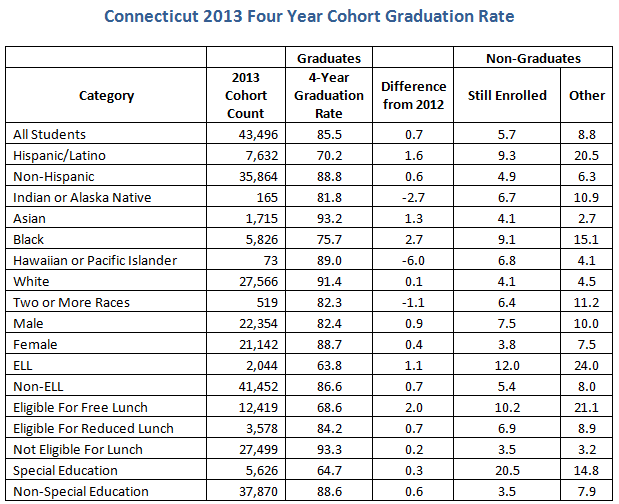
Through the Alliance District program, the State provides increased funding tied to greater accountability for the 30 lowest performing school districts. During the past four years, over $407 million has been invested into the Alliance Districts to help them strengthen their schools and improve outcomes for students.
The Educational Reform Districts, a subset of the Alliance Districts and among the 10 lowest performing in the state, showed an 8-point gain since 2011. In East Hartford Public Schools, an educational reform district, East Hartford High School saw its graduation rate reach 94.6 percent, up 14.5 points from 2011.
"We are tremendously proud of the work of our schools around improving student graduation rates. Our administrators and teachers have made it a point to focus on providing students with the necessary skills to improve student performance. I appreciate their hard work and the commitment to our students and families," said East Hartford Superintendent Nathan Quesnel.
Schools and districts across the state continued to improve and strengthen supports for all students. Windham School District, an educational reform district, increased 19.8 points since 2011 to 80.8 percent graduation rate in 2015.
IMPROVEMENT AMONG HIGH NEEDS STUDENTS
In 2015, a subgroup of high needs students, which includes English learners, those eligible for free or reduced price lunch, and students receiving special education services, saw another increase in the graduation rate to 76.1 percent. Over the past five years, the graduation rate for our high needs students has jumped 11.2 points.
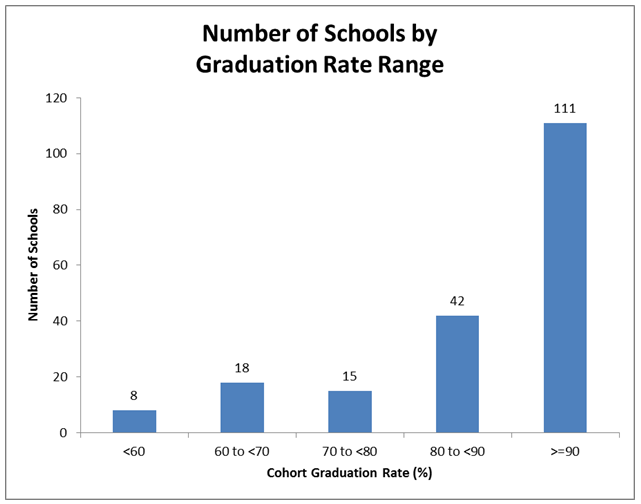
Also in 2015, graduation rates for black and Hispanic students dramatically increased over the past five years, outpacing the average growth for the state. The graduation rate for black students reached 78.1 percent in 2015, up 6.9 points since 2011. For Hispanic students, the graduation rate reached 74.8 percent in 2015, up 10.6 points since 2011. Connecticut also made strides in improving the graduation rate for English learners, which reached 66.7 percent in 2015, up 7.3 points since 2011.
Graduation rates are calculated according to the Adjusted Cohort Graduation Rate method, which the National Governors Association developed and is considered to be the most precise method. These rates represent the percentage of first-time ninth-grade students who graduated with a regular high school diploma in four years or less. It is based on individual student-level data, excludes ninth-grade repeaters, late graduates, and accounts for transfers in and out of the graduating class over the four-year period.
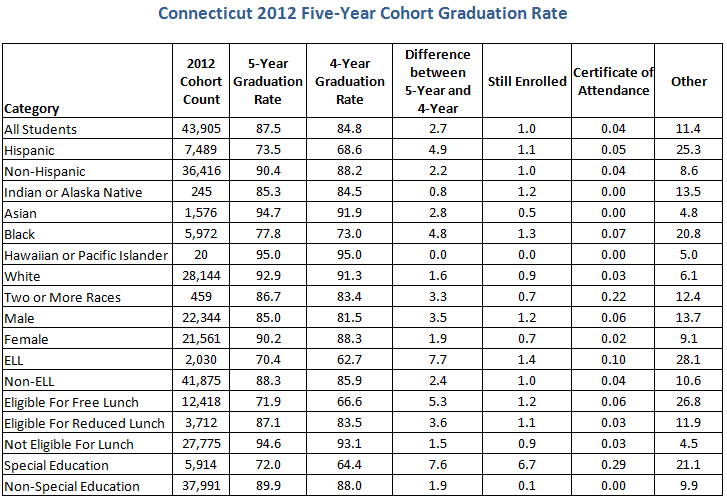
Notes:
- With the exception of the 2015 cohort count column, which is a count of students, all remaining columns represent percentages. Row percentages may not add up to 100 percent because of rounding.
- A student is included in the ELL, special education, or free/reduced lunch subgroup, or any combination of them, if he or she was reported in that subgroup in at least one of the Public School Information System data collections over the course of his or her high school career.
- In reporting race/ethnicity, the student's last reported category is used.
- High Needs subgroup includes students categorized as free/reduced lunch, or English language learner, or Students with disabilities.
- Special Education students who are still in school after four years but have earned the academic credits to graduate are included in the "still enrolled" column for this calculation.
- The Cohort Count is as of the end of the 2014-15 school year.
- Four-Year Graduation Rate is the percentage of students who received a standard diploma within four years including early and summer graduates from the cohort.
- Still Enrolled means students were still in school after four years.
- Other category includes students who dropped out (including those who enrolled in an adult education program), or transferred to postsecondary education, or transferred to another school district but never enrolled in that district, or have an unknown status.

The graduation rate gap between black students and white students decreased to a 14.6-point gap-down from 18.2 points in 2011. Overall, the gap has decreased 3.6 points since 2011.
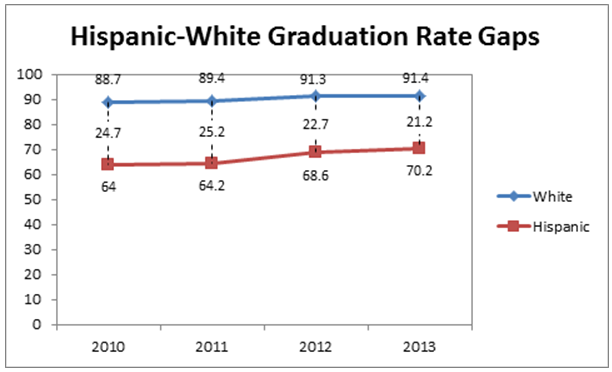
The graduation rate gap between Hispanic students and white students decreased to a 17.9-point gap-down from 25.2 points in 2011. Overall, the gap decreased 7.3 points since 2011.
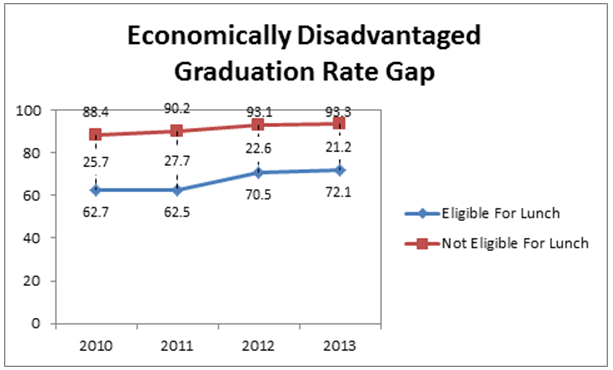
Using free and reduced-priced meal eligibility as an indicator of family wealth, the graduation rate gap between low-income students and their more affluent peers decreased to a 19.3-point gap-down from 27.7 points in 2011. Overall, the gap decreased by 8.4 points since 2011.
While the increases among the graduation rates for students from subgroups are encouraging, significant gaps remain. Specifically, among black students and Hispanic students eligible for free lunch, there are substantial differences in graduation rates between males and females.
METHODOLOGY AND DOCUMENTATION
**Download: Complete documentation regarding the cohort graduation rate
The Connecticut State Department of Education (CSDE) introduced the four-year cohort graduation rate with the graduating class of 2009. This approach was created when Connecticut and 49 other states signed an agreement with the National Governors Association to develop a uniform system for tracking students. The four-year cohort graduation rate is calculated by tracking an individual cohort, or group of students, from their initial entrance into Grade 9 through to graduation. The four-year cohort graduation rate represents the percentage of students who earn a standard high school diploma within four years. The calculation uses individual student-level data from the state's Public School Information System (PSIS) that school districts submitted and superintendents certified.
- Twitter: @GovMalloyOffice
- Facebook: Office of Governor Dannel P. Malloy


